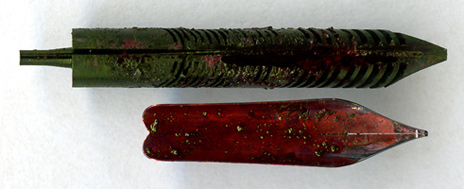Pen Maintenance
Just as your car needs its oil changed, your fountain pen needs internal cleaning. A once a month cleaning will often save you a trip to the nib specialist. After flushing the ink out of the pen with water, we recommend flushing with one part household ammonia* and two parts water. Fill and empty the pen three or four times to dissolve the solids accumulation. Then flush the ammonia solution out of the pen with three or four more flushes with tap water. This is especially important if you change brands or even colors of ink, or use a cartridge exclusively (some inks react with each other, creating a viscous substance).
Even if you just flush several times with tap water on an irregular basis, you should be able to avoid most clogging problems. *Important note: never use ammonia on the barrels of Wahl Eversharp pens from the 20's or 30's, or any other pen with aluminum parts. The ammonia eats aluminum quite fast! Also, do not soak the barrels of nitrocellulose pens in ammonia for any length of time. It can discolor the plastic.
Many piston-filler pens, such as Pelikan and OMAS brand pens, will begin to twist hard if ink is allowed to cake inside the barrel. In an extreme case this can compromise the gasket or even break the twist mechanism. If you can see accumulated dry ink in the transparent part of a Pelikan pen, you can see how this problem occurs and take remedial action yourself.
Cartridge/converter pens also need to be cleaned regularly - especially if cartridges are used most. Never put your pen away for an extended period with a cartridge full of ink in the pen. Very often, cartridge/conveter filling system pens are the ones that are rarely, if ever, flushed. However, it's just as easy to maintain these pens as it is for twist plunger filler pens. Use the converter to flush with the one part household ammonia and two part water solution.
FYI: A "de-soldering bulb" available from Radio Shack for about $5.00 makes a great flushing tool. Remove the nylon tip and slide the mouth of the bulb over the back of the section and pump away. An ear syringe also may work. With household ammonia as a flusher, many plugged pens can be cleaned.
If the feed is just too plugged for flushing, of course send it in for our cleaning. We have specialized tools for clearing even the worst problems, such as impacted waterproof ink. However, because we cannot always see this plugged condition when the pen arrives for assessment, we sometimes have to add charges in order to clean out the feed system. The complaint is frequently that the pen has started skipping or drying out and the nib is believed responsible.
Inks Dos-and Dont's
We get many questions regarding what inks to use and what inks not to use. The first thing we should mention is that we are not ink specialists. That said, over the years we have found that India inks and waterproof drafting inks tend to cause problems in fountain pens that are not cleaned directly after each use. Because these inks do not dissolve in anything that will not dissolve the pen or feed itself, the resulting clog is extremely hard to remove. We have also found that some red inks have a propenstiy for clogging feeds.
What is the safest solution? First of all, sticking to conventionally formulated fountain pen inks, such as those we sell on our own inks page. If you want to experiment, try sticking to carbon or pigment-based inks that are specificially formulated for fountain pens, such as those made by Platinum and Sailor. And whatever ink you use, regular cleaning will help insure your pen's feed system will have a long and happy life.
The Plugged Feed Problem
Ultimately, extensive hand-cleaning allowed all three of these feeds to be returned to full working condition - but with even casual regular cleaning, none of these feeds would likely ever have needed such extensive attention. Regular cleaning, as outlined above, can save your pens a trip to the nib works.
If you have trouble and want us to do it...
We can disassemble and get it flowing properly.

and nib plugged with red ink.
into working order and, through nib adjustments and
feed alterations, make them better than ever.
